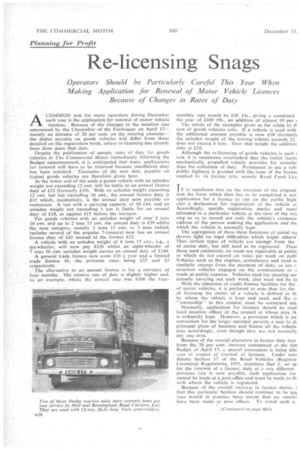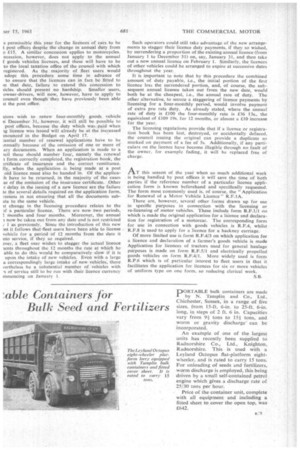Planning for Profit
Page 70

Page 73

If you've noticed an error in this article please click here to report it so we can fix it.
Re-licensing Snags
Operators Should be Particularly Careful This Year When Making Application for Renewal of _Motor Vehicle Licences Because of Changes in Rates of Duty
A-' COMMON task for many operatOrs during December 'each-year is the application for renewal of motor vehicle
. licences.., Because of the changes in the taxation rate announced, by the Chancellor of the Exchequer on April 17— namely an increase of 20 per cent. on the existing amounts— the duties payable on goods vehicles will differ from those detailed on the registration book, unless re-licensing has already been done since that date.
Despite the publication of sample rates of duty for goods vehicles in The Commercial Motor immediately following the Budget antiouncemeM, it is anticipated that many applications for renewal will have to be returned because insufficient duty has been remitted. " Examples of the new duty payable on typical goods vehicles are therefore given here. At the lower end of the scale a goods vehicle with an unladen weight not exceeding 12 cwt. will be liable to an annual licence duty of 112 (formerly £10). With an unladen weight exceeding 12 cwt. but not exceeding 16 cwt., the annual licence duty is £15 which, incidentally, is the annual duty now payable on motorcars.. A van with a carrying capacity of 10 cwt. and an unladen weight not exceeding 1 ton is liable for an annual duty of £18, as against £15 before the increase. •
For goods vehicles' with an unladen weight of over 2 tons 10"cwt. and up to 2 tons 15 cwt. the annual duty is £39 whilst the -next -category, namely 2 tons 15 cwt. to 3 .tons (which includes several of the popular 7-to.nners) now has an annual
licence duty of 142 instead of the former £35. .
A vehicle with an unladen weight of 6 tons .15 cvvt., e.g., a• six-wheeler, will now pay .k126 whilst an eight-wheeler of 7 tons I0 cwt, unladen weight carries an annual duty of £144.
• A general trade licence now costs £30 a year and a limited trade licence £6, the previous rates being £25 and £5 respectively.
. The alternative to an annual licence is for a currency of fourmonths. The relative rate of duty is slightly higher and, as 'anexample,"•Where the annual rate was £100 the four
monthly rate would be £36 13s., giving a combined the year of 1109 19s., an addition of almost 10 per
The whole of the examples given so far relate to tt Lion of goods vehicles solo. If a vehicle is used with the additional amount payable is now £18 -(former13 the unladen weight of the towing vehicle exceeds 21 does not exceed 4 tons. Over that weight the addition duty is £24.
Although the re-licensing of goods vehicles is such task it is sometimes overlooked that the initial licens mechanically propelled vehicle provides for somethi than the collection of duty. Permission to use a vehi public highway is granted with the issue of the licenct implied by its former title. namely Road Fund LiCE IT is significant that on the occasion of the original tion the form which then has to he completed is not application for a licence to run on the public high' also a declaration for registration of the vehicle cc Accordingly, specific registration marks and numl allocated to a particular vehicle at the time of the init sing so as to record not only the vehicle's existence address of the person making the application and thr which the vehicle is normally kept.
The segregation of these three functions of initial reg throws light on legal difficulties which might otherw. Thus certain types of vehicle are exempt from the of excise duty, but still need to be registered. Thest those used exclusively on roads not repairable at public or which do not exceed six miles per week on publ Vehicles such as fire engines, ambulances and road rc similarly exempt from the payment of duty, as are r, struction vehicles engaged on the construction or r roads at public expense. Vehicles used for clearing sac actually carrying out such work, also need not be ta With the extension of credit finance facilities for the of motor vehicles, it is pertinent to note that for. the of licensing the owner of a vehicle is defined as th by whom the vehicle is kept and used, and the e: "ownership" in this, context must be construed ace Normally, aPplication for licences should be mad local taxation officer of the council in whose area th• is ordinarily kept. However, a provision which is pai convenient for the larger operator permits a user to dc principal place of business and license all his vehicle area accordingly, even though they are not normally any one area. • Because of the overall alteration in licence duty fees from the 20 per cent, increase announced at the tirn Budget of April 17, a special concession is being alle year in respect of renewal of licences. Under non ditions Section 17 of the Road Vehicles (Registrat Licensing) Regulations, 1955, stipulates that if, on ap for the renewal of a licence, duty at a rate different previous rate 'is now payable, such application for cannot be made at a post office and must he made to th with whom the vehicle is registered.
Because of the overall increase in licence duties, i that this particular Section should continue to be api. year would in practice have meant that no renews have been made at post. offices. To avoid such a
s permissible this year for the licences of cars to be t post offices despite the change in annual duty from o £15. A similar concession applies to motorcycles. ncession, however, does not apply to the annual f goods vehicles licences, and these will have to be to the local taxation office of the council with which registered. As the majority of fleet users would adopt this procedure some time in advance of to ensure that the licences can in fact be fitted to in that date, failure to extend this concession to
licIes should present no hardship, Smaller users, owner-drivers, will now, however, have to apply to council even thoughthey have previously been able kt the post office.
ators wish to renew four-monthly goods vehicle n December 31, however, it will still be possible to post offices, because the duty which was paid when ig licence was issued will already be at the increased mouneed in the Budget on .April 17. Lantial number of renewal applications have to be Lnnually because of the omission of one or more of ary documents. When an application is made to a 161 these should number four, namely the renewal 1 form correctly completed, the registration -book, the maificate of insurance and the correct remittance. Ely, when the application is being made at a post old licence must also be handed in. Of the applica:h have to be returned, in the majority of the cases se of the omission of the insurance certificate. .Other r delay in the issuing of a new licence are the failure te the several details required on the application form, !ssness in not ensuring that all the documents subate to the same vehicle.
it change in the licensing procedure relates to the 3f a particular licence. There are now two periods, Months and four months. Moreover, the annual now be taken out from any date and is not restricted ,7 1 as previously. Since the introduction of this new :nt it follows that-fleet users have been able to license vehicle for a period of 12 months from the date it nto service, if they so required.
ever, a fleet user wishes to stagger the actual licence lents throughout the 12 months the rate at which he able to do this would be comparatively slow if it is upon the intake of new vehicles. Even with a large a correspondingly large intake of new vehicles, there vertheless be a substantial number of vehicles with -s of -service still to be run with their licence currency mmencing on January 1. Such operators could still take advantage of the new arrangements to stagger their licence duty payments, if they. so wished, by surrendering a proportion of the existing annual licence (from January I to December 31) on, say, January 31, and then take out a new annual licence on February 1. Similarly, the licences of other vehicles could be arranged to expire at successive dates throughout the year..
It is important to note that by this procedure the combined amount of duty payable, i.e., the initial portion of the first licence less the surrendered portion, and, of course, the subsequent annual licence taken out from the new date, would both be at the cheapest, i.e., the annual rate of duty. 'The other alternative, to secure a staggering of licence payments by licensing for a four-monthly period, would involve payment of extra pro rata duty. As already stated, where the annual rate of duty is £100 the four-monthly rate is £36 13s., the equivalent of £109 19s. for 12 months, or almost a £10 increase for the year.
The licensing regulations provide that if a licence or registration book has been lost, destroyed, or accidentally defaced, the council issuing the original can provide a duplicate so marked on payment of a fee of 5s. Additionally, if any particulars on the licence have become illegible through no fault or the owner, for example fading, it will be replaced free of charge.
AT this season of the year when so much additional work is being handled by post offices it will save the time of both parties if the reference number of a particular licence application form is known beforehand and specifically requested. The form most commonly Used is. of course, the "Application for Renewal of a Motor Vehicle Licence" R.F.1A.
There are, however, several other forms drawn up for use in specific purposes in connection with the licensing or re-licensing of motor vehicles. These include form R.F.1/I on which is made the original application for a liCence and declaration for registration of a motorcar. The corresponding form for use in connection with goods vehicles is R.F.4, whilst R.F.8 is used-to apply for a licence for a hackney carriage.
Of more limited use is forni R.F.4/3 on which application for a licence and declaration of a farmer's goods vehicle is made Application for licences of tractors used for general haulage purposes is made on form R.F.5/I and electrically propelled goods vehicles on form R.F.4/1. More widely used is form R.F.6 which is of particular interest to fleet users in that it facilitates the applicatiLin for licences for six or more vehicles of uniform type on one form, so reducing clerical work.




















































































































